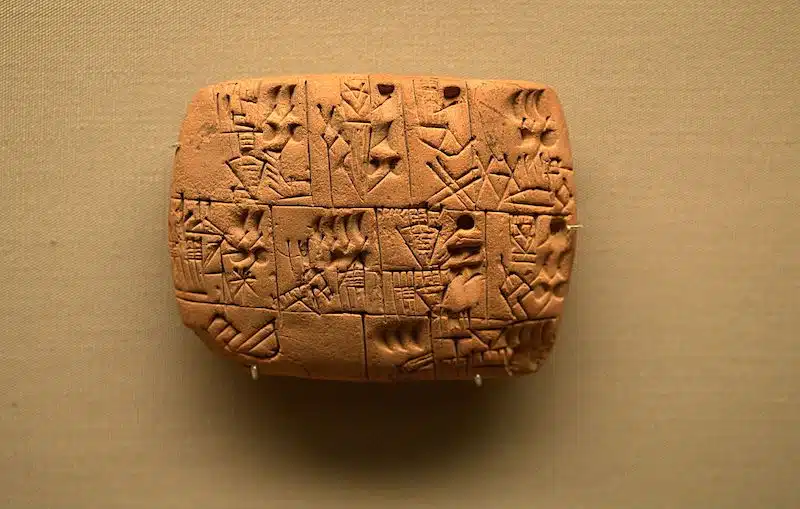
The Kish Tablet from Sumer with pictographic writing, c. 3500 BCE. Ashmolean Museum, Iraq (Photo: José-Manuel Benito via Wikimedia Commons).
Nestled in the historical region of southern Mesopotamia, Sumer stands as the earliest known civilization. It’s no surprise, then, that the oldest written text can be traced back to Kish, an ancient Sumerian city in modern Tell al-Uhaymir, Iraq. Named after the location of its discovery, the Kish Tablet dates back to the Uruk period (c. 3500–3200 BCE), and features proto-cuneiform signs.
Proto-cuneiform emerged in Mesopotamia and was largely rooted within a pictographic system. These pictographs spanned simple drawings and symbols representing specific ideas and, unlike modern languages, did not directly correspond to the syntax of a spoken language. The purpose of proto-cuneiform was not to transcribe linguistic messages, but instead to maintain economic records, especially as they related to production, trade, and labor.
These elements can make it difficult to decipher proto-cuneiform artifacts, including the Kish Tablet. Though it hasn’t been decoded or demonstrated to correspond to spoken language, the tablet nevertheless offers an indispensable glimpse into the evolution of writing throughout ancient history. The proto-cuneiform marks on the Kish Tablet reflect a transitional stage between a purely pictographic writing system and the more sophisticated and syllabic cuneiform that developed in the region by the end of the fourth millennium BCE.
Unlike its predecessor, cuneiform correlated more with spoken language, incorporating symbols that formed distinct words when read together. Cuneiform, however, demanded a creation process similar to proto-cuneiform. Symbols were impressed into soft clay tablets with a stylus, hardening quickly in Mesopotamia’s hot climate. This remarkable durability not only made clay tablets an attractive option for record-keeping but has allowed us to recover such artifacts several millennia later.
The Kish Tablet is an astounding reminder of how writing has advanced across time, and provides essential insights into Sumerian culture. The original tablet is currently held at the Iraq Museum in Baghdad, while a plaster cast can be found at the University of Oxford’s Ashmolean Museum.
The Kish Tablet is the oldest written text in the world and uses proto-cuneiform pictographs.

Proto-cuneiform tablet recording the allocation of beer, c. 3100-3000 BCE. Collection of the British Museum (Photo: Jim Kuhn, via Wikimedia Commons).
Proto-cuneiform did not directly correspond to the syntax of a spoken language, but was instead primarily used to maintain economic records.

Proto-cuneiform tablet of an administrative account with entries concerning malt and barley groats (Photo: The Metropolitan Museum of Art, donated to Wikimedia Commons).
Cuneiform followed proto-cuneiform by the end of the fourth millennium BCE and correlated more with spoken language.

A large cuneiform inscription found on the south side of the Van Castle Hill in eastern Turkey (Photo: Bjørn Christian Tørrissen, via Wikimedia Commons).
Sources: Proto-Cuneiform tablet with seal impressions: administrative account of barley distribution with cylinder seal impression of a male figure, hunting dogs, and boars; Proto-Cuneiform: Earliest Form of Writing on Planet Earth; A Short History of Proto-Cuneiform; The Origins of Writing
Related Articles:
Listen to the World’s Oldest Sheet Music, a Mesopotamian Hymn Over 3,000 Years Old
What Is Ancient Assyrian Art? Discover the Visual Culture of This Powerful Empire
17,000 Looted Ancient Artifacts Return to Iraq in Massive Repatriation
